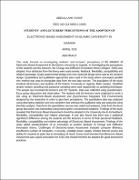| dc.description.abstract | This Study Focused On Investigating Students’ And Lecturers’ Perceptions Of The Adoption Of Electronic-Based Assessment In The Islamic University In Uganda. In Investigating The Perceptions Of The Students And The Lecturers, The Change And Diffusion Innovation Theory (Rogers, 2003) Was Adopted. Four Attributes From The Theory Were Used Namely: Feedback, Flexibility, Compatibility And Relative Advantage. Quasi Experimental Design And Cross-Sectional Design Were Used As The Research Design. Quantitative And Qualitative Approaches Were Used In The Study Where Convergent Parallel Mix Method Was Used To Triangulate Data From The Two Data Sources. The Population Of The Study Involved All Lecturers And Students Of The Islamic University In Uganda, Main Campus. Stratified Simple Random Sampling And Purposive Sampling Were Used Respectively As Sampling Techniques. The Sample Size Involved 60 Lecturers And 237 Students. Data Was Collected Using Questionnaire, Focus Group Discussion And Observation. The Students And The Lecturers Were Subjected To Write A Test Using An Electronic-Based Assessment Tool (Synchronous Integrated Test Environment) Designed By The Researcher In Order To Give Their Perceptions. The Quantitative Data Was Analyzed Using Descriptive Statistics And One-Sampled T-Test Whereas The Qualitative Data Was Analyzed Using Thematic Analysis. Data From The Quantitative Sources Was Coded And Analyzed. Data From The Focus Group Discussion Was Transcribed Using Transcription Conventional Notations. Findings Of The Study Revealed That Electronic-Based Assessment Should Be Adopted In The University Due To Its Feedback, Flexibility, Compatibility And Relative Advantage. It Was Also Found That There Was A Statistical Significant Difference Among The Students And The Lecturers In Terms Of Their Perceived Feedback, Flexibility, Compatibility And Relative Advantage Of Electronic-Based Assessment. Findings Of The Study Added Standardization Of An Innovation As Another Attribute Of Change And Diffusion Innovation Theory. Challenges Of Electronic-Based Assessment Included Computer Illiteracy, Insufficient Number Of Computers, E-Security, Unstable Power Supply, Limited Internet Access And Ability For Students To Panic Due To Immediacy Of Result. It Was Recommended That Electronic-Based Assessment Was A Good Innovation For Iuiu And Should Therefore Be Adopted For Good Assessment Practices. | en_US |

